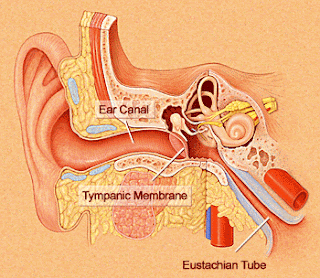A diagnosis of cancer carries a lot of significance for the patient who receives the diagnosis. But is it always cancer? Can it be another disease masquerading as cancer? It is rare, but it can happen as a case report by Smulders YE et al. published in the Journal of Medical Case Reports demonstrates.
They report a case of a 50 year old Caucasian male referred to their clinic. He had complaints of dysphonia (difficulty in speaking), dysphagia (difficulty in swallowing), and odynophagia (pain while swallowing). He also had a complaint of pain going to his right ear. All these had been going on for two months. The patient also suffered from recurrent aspiration of liquids and had lost 3 kg of body weight.
 |
| The larynx. From Wikipedia. |
The authors visualized his larynx (voice box) with a laryngoscope. There was an ulcer on the right false vocal cord (present above the true vocal cords, also called ventricular fold or vestibular fold) which extended to the
epiglottis (a cartilage of the larynx). The right true vocal cord was edematous and mobility of the vocal cord was decreased. Contrast enhanced CT scan of the neck showed an enhanced mass present in the right false cord which had extended in to the anterior commissure (front end of the vocal cords) and upwards in to the
piriform sinus.
 |
(A) Initial antero-posterior chest X-ray. Miliary nodules predominantly bilaterally distributed in the upper parts of the lung parenchyma. (B) Axial contrast-enhanced computed tomography image of the neck: enhanced mass (arrows) in the false vocal cord which extends into the anterior commissure and obliteration of the paraglottic fat (arrowhead). (C) Axial high resolution computed tomography image of the chest: diffusely distributed interstitial nodular alterations with formation of central cavities (arrows).
Smulders et al. Journal of Medical Case Reports 2009 3:9288 doi:10.1186/1752-1947-3-9288 |
Direct
laryngoscopy under general anesthesia showed a tumor covering the entire right false vocal cord with extension to the laryngeal surface of the epiglottis without involvement of the glottis (true vocal cord). A routine chest X-ray showed mainly bilaterally distributed miliary nodules in the upper part of the lung parenchyma. Full blood count and electrolytes were within normal limits. No lymph nodes were involved in the neck. The clinical diagnosis was T3N0 supraglottic laryngeal carcinoma.
Let us stop here and take a look at the rationale behind the diagnosis. The man was 50 years old. Laryngeal carcinoma commonly occurs in this age group. He was a smoker for 40 years. Smoking is a known risk factor for laryngeal carcinoma. All the symptoms fit laryngeal carcinoma. Imaging and endoscopic visualization showed a tumor like mass in the larynx. T3 means the tumor is limited to the larynx with vocal cord fixation and/or invasion of the following – postcricoid area (area behind the cricoid cartilage), pre-epiglottic tissues, paraglottic space and/or minor cartilage invasion. N0 means no lymph nodes were involved by the carcinoma.
Is there any reason to doubt the diagnosis? The only thing is that the chest X-ray does not fit in the picture. The finding of the chest X-ray is more consistent with tuberculosis. But I can say this only because I have the advantage of hindsight; I already know what the diagnosis is. Moreover there are other conditions that may be consistent with the X-ray finding.
The authors then did a histopathological examination of the tumor mass. This is
the diagnostic test and it sprang forth a surprise. They did not find any malignancy in the mass. Instead they found tuberculosis. This was a case of tuberculosis of the larynx in the guise of a laryngeal malignancy. They also found tubercle bacilli in the sputum of the patient meaning it was quite possible for the patient to infect others.
A CT scan of the chest of the patient showed cavity formation in the lungs, indicating pulmonary tuberculosis. Two nurses, two of the patient’s relatives and two of his friends tested positive in skin with
purified protein derivative (PPD). The patient was treated with antituberculous drugs and the contacts were treated prophylactically with tuberculostatics.
This case demonstrates that you can never be too sure in medicine. The features of laryngeal cancer and laryngeal tuberculosis are overlapping and there needs to be an index of suspicion to differentiate the two. Tuberculosis can cause all the symptoms of laryngeal carcinoma, from weight loss to tumor like mass. Here there was a clue in the chest X-ray finding but without a degree of suspicion, TB is not the first thing that would come to your mind. In this case, the laryngeal tuberculosis was probably secondary to the pulmonary tuberculosis with the larynx becoming infected from the coughed up tubercle bacilli. I would have been interested to know if the patient had been suffering from chronic cough, which I strongly suspect as his contacts came out to be positive in the PPD test. Erythrocyte sedimentation rate would also have given a clue as it would have been elevated in TB.
Merry Christmas!
Reference :
Smulders, Y., De Bondt, B., Lacko, M., Hodge, J., & Kross, K. (2009). Laryngeal tuberculosis presenting as a supraglottic carcinoma: a case report and review of the literature Journal of Medical Case Reports, 3 (1) DOI: 10.1186/1752-1947-3-9288












